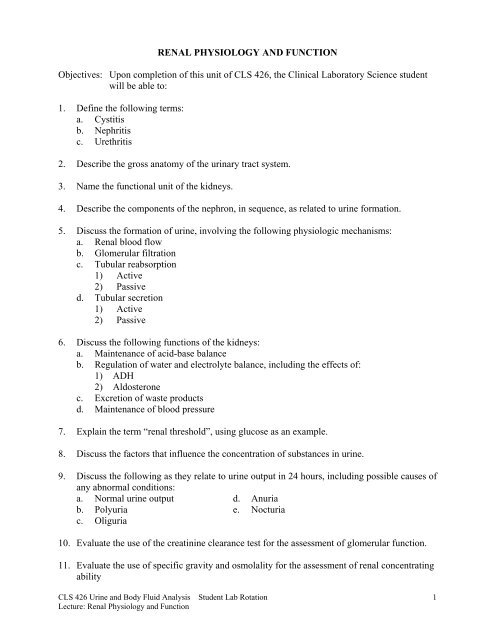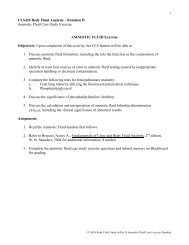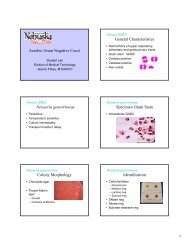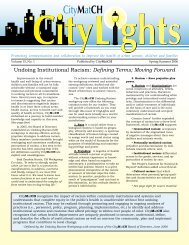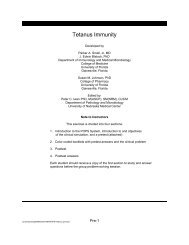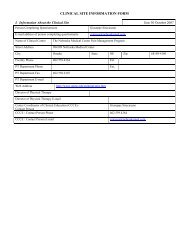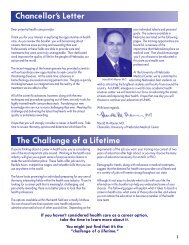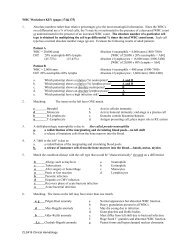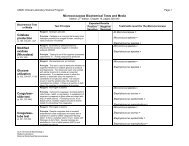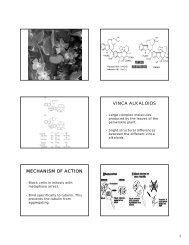RENAL PHYSIOLOGY AND FUNCTION Objectives: Upon ... - UNMC
RENAL PHYSIOLOGY AND FUNCTION Objectives: Upon ... - UNMC
RENAL PHYSIOLOGY AND FUNCTION Objectives: Upon ... - UNMC
You also want an ePaper? Increase the reach of your titles
YUMPU automatically turns print PDFs into web optimized ePapers that Google loves.
<strong>RENAL</strong> <strong>PHYSIOLOGY</strong> <strong>AND</strong> <strong>FUNCTION</strong><strong>Objectives</strong>: <strong>Upon</strong> completion of this unit of CLS 426, the Clinical Laboratory Science studentwill be able to:1. Define the following terms:a. Cystitisb. Nephritisc. Urethritis2. Describe the gross anatomy of the urinary tract system.3. Name the functional unit of the kidneys.4. Describe the components of the nephron, in sequence, as related to urine formation.5. Discuss the formation of urine, involving the following physiologic mechanisms:a. Renal blood flowb. Glomerular filtrationc. Tubular reabsorption1) Active2) Passived. Tubular secretion1) Active2) Passive6. Discuss the following functions of the kidneys:a. Maintenance of acid-base balanceb. Regulation of water and electrolyte balance, including the effects of:1) ADH2) Aldosteronec. Excretion of waste productsd. Maintenance of blood pressure7. Explain the term “renal threshold”, using glucose as an example.8. Discuss the factors that influence the concentration of substances in urine.9. Discuss the following as they relate to urine output in 24 hours, including possible causes ofany abnormal conditions:a. Normal urine output d. Anuriab. Polyuria e. Nocturiac. Oliguria10. Evaluate the use of the creatinine clearance test for the assessment of glomerular function.11. Evaluate the use of specific gravity and osmolality for the assessment of renal concentratingabilityCLS 426 Urine and Body Fluid Analysis Student Lab RotationLecture: Renal Physiology and Function1
<strong>RENAL</strong> <strong>PHYSIOLOGY</strong> <strong>AND</strong> <strong>FUNCTION</strong>IRenal FunctionA. Urine formation is the primary excretory function of the kidneysB. The kidneys function to regulate the body's internalenvironment, maintaining homeostasis:1. Maintains acid-base balance of the body2. Regulates body fluids and water balance3. Aids in maintenance of blood pressure4. Maintains electrolyte balance5. Excretes potentially toxic waste products6. Reabsorbs essential substances7. Hormonal functiona. Serves as target organ for certain hormones (aldosterone, ADH)b. Influences the metabolism of certain hormones (Vitamin D)c. Secretes regulatory hormones (erythropoietin)d. Secretes the enzyme Renin (Renin-Angiotensin-Aldosterone Axis)C. Kidney function is dependent upon proper:1. Renal blood flow (~20-25% of cardiac output circulates to renal artery)2. Glomerular filtration3. Tubular reabsorption4. Tubular secretionII.Components of the Urinary Tract System (gross, macro level)A. Kidneys1. Bean-shaped paired organs located in the small of the back2. Each kidney: ~ 12 cm long, 5-7 cm wide, 2.5 cm thick, weigh 150 grams3. Two distinct areas apparent on cross sectiona. Outer cortex layer (granular in appearance)b. Inner medulla layer (renal tissue shaped into pyramids)4. Inflammation/infection of kidney = nephritis (pyelonephritis)B. Renal Pelvis: Funnel-shaped, receives urine from themajor calyces; funnels urine into the ureterC. Ureter: Fibromuscular tube approx 25 cm long; one ureterextends down from each kidney and connects to the bladderD. Bladder: Muscular sac, shaped like a pyramid; acts as a‘holding tank’ for temporary urine storage until voided;Inflammation/infection of the bladder wall = cystitisE. Urethra: Canal connecting the bladder to the exterior of bodyLength: males = 24 cm, women = 4 cm;Inflammation/infection of urethra = urethritisCLS 426 Urine and Body Fluid Analysis Student Lab RotationLecture: Renal Physiology and Function2
III.Components of the Nephron (micro level)A. Functional unit of the kidneyB. Component parts1. Glomerulus (renal corpuscle, cortex only)2. Tubulesa. Proximal convoluted tubuleb. Loop of henlec. Distal convoluted tubuled. Collecting tubule (duct)C. Function1. Urine formation2. Three distinct processesa. Filtrationb. Reabsorptionc. SecretionIV.GlomerulusA. Component parts1. Consists of a capillary network (or tuft) surrounded by a thin layer of cellsknown as Bowman's capsule (Bowman’s space)2. Afferent arteriole feeds into the glomerulus3. Efferent arteriole exits the glomerulus and extends into a network ofperitubular capillaries4. Ultrafiltrate empties into the proximal convoluted tubule (PCT)B. Function: FILTRATION of plasma1. Serves as a non-selective filter of plasma substancesa. Allows free passage of water, electrolytes and plasma substanceswith low molecular weight (
2. Difference between glomerular filtrate and plasma is the absence ofa. Large plasma proteins (>70,000)b. Protein-bound substances (bilirubin, drugs, etc)c. Cells (RBC, WBC)3. Glomerular filtrate (filtered urine) is referred to as an ‘ultrafiltrate’ ofplasma with specific gravity = 1.0104. Ultrafiltrate volume = 120 ml/minute5. Filtration of plasma is dependent upona. Normal cellular structure of glomerulus (basement membrane)b. Hydrostatic pressure: due to size difference of afferent and efferentarteriolesc. Oncotic pressure: due to unfiltered plasma proteinsd. Feedback mechanisms: Aldosterone-Renin-Angiotensin system1) Responds to changes in blood pressure and plasma sodiumDecreased BP; decreased plasma sodium2) Monitored by juxtaglomerular apparatus: specialized cellsin the afferent arteriole and distal convoluted tubule3) Renin: enzyme produced by the juxtaglomerular cellsAldosterone: hormone produced by adrenal cortexAngiotensinogen: protein substrate produced by liverCLS 426 Urine and Body Fluid Analysis Student Lab RotationLecture: Renal Physiology and Function4
V. Renal TubulesA Component parts1. Proximal Convoluted Tubule (PCT)2. Loop of Henle: consists of descending and ascending limbs3. Distal Convoluted Tubule (DCT)a. Antidiuretic Hormone (ADH) controls water permeability of DCTb. Aldosterone controls sodium reabsorption by DCT4. Collecting Tubule or Ductsa. ADH controls water permeability of collecting ductsB. Function1. REABSORPTION of substances needed by the body, from tubules backinto the bloodstream (glucose, amino acids, water, electrolytes)2. SECRETION of substances not needed by the body, from the bloodstreaminto the tubules/urine for excretion (toxins, drugs, metabolic wasteproducts)3. Final urine output:a. 1 ml/minute (recall glomeruli produce 120 ml/min of filtrate)b. Dependent on hydration status: can range from 0.3 ml/min(dehydrated) to 15 ml/min (excessive hydration)C. Tubular transport mechanisms1. Active transporta. Substance to be reabsorbed must combine with a carrier proteinlocated in the membrane of the renal tubular cellsb. This interaction creates electrochemical energyc. Energy is used to transfer substance across cell membrane backinto bloodstreamCLS 426 Urine and Body Fluid Analysis Student Lab RotationLecture: Renal Physiology and Function5
2. Passive transporta. Simple diffusionb. Molecules move across cell membranes due to concentrationdifferences on opposite sides of membranec. No energy is involved in this process3. Renal thresholda. Plasma concentration of a substance at which reabsorption stopsb. Active and passive transport can be influenced by the plasmaconcentration of the substancec. Maximal reabsorptive capacity is reachedd. Example: glucose = 160-180 mg/dlTubular ReabsorptionMechanism Substance LocationActivetransportPassivetransportglucose, amino acids, HCO3, saltschloridesodiumWaterureasodiumPCTAscending loop of HenlePCT, DCTPCT, descending loop of Henle, collecting tubulesPCT, ascending loop of HenleAscending loop of Henle (carried with chloride)VI.Normal Urine CompositionA. Water (94%)B. Solutes (6%)1. Chemical (organic) substances: metabolic wastea. Ureab. Creatininec. Uric acid2. Electrolytes and ions (inorganic solids)a. Salt as NaCl (sodium and chloride)b. Potassiumc. NH4d. Inorganic phosphates (PO4)e. Inorganic sulfates (SO4)f. Hormones, vitamins, medicationsg. Threshold substances (ex: glucose)C. Factors which influence the 'concentration of substances' found in the urine:1. Dietary intake2. Physical activity3. Body metabolism4. Endocrine function (ADH, Aldosterone)5. Body position (orthostatic proteinuria)CLS 426 Urine and Body Fluid Analysis Student Lab RotationLecture: Renal Physiology and Function6
VII.Urine OutputA. Average 24 hour output1. Normal: _________________________2. Extreme: _________________________B. Factors influencing urine volume1. Fluid intake2. Non-renal fluid loss (vomiting, diarrhea, sweating)3. Secretion of ADH (too much, too little)4. Body’s need to excrete solutes such as glucose, salt or ureaC. Abnormal Urine Output1. Polyuriaa. Increased urine output (>2500 ml/24 hr)b. Causes of polyuria1) Artificially induced by suppression of ADH (diuretics,caffeine, alcohol)N2. Oliguriaa. Defined as:2) Diabetes mellitus: condition of abnormal carbohydratemetabolism; plasma glucose levels rise, exceeding renalthreshold, causing glucose to be excreted into the urineresulting in polyuria3) Diabetes insipidus: abnormality in ADH secretion ortubular response to ADH, resulting in polyuriaa) Neurogenic diabetes insipidus: pituitary gland doesnot produce ADHb) Nephrogenic diabetes insipidus: renal tubules do notrespond to ADHb. Occurs when:N3. Anuriaa. Defined as:b. Occurs when:CLS 426 Urine and Body Fluid Analysis Student Lab RotationLecture: Renal Physiology and Function7
N4. Nocturiaa. Defined as:b. Occurs when:VIII.Renal Function TestsA. Assessment of Tubular Reabsorption1. Used to assess the kidney's ability to concentrate the urine2. Good test to detect early renal disease3. Collectively termed CONCENTRATION TESTS. Urine concentration islargely determined by the body’s state of hydration, and the normal kidneywill reabsorb only the amount of water necessary to preserve an adequatesupply of body water. Thus, control of fluid intake must be incorporatedinto test protocola. Fluid Deprivation Testb. Free Water Clearance Test4. Laboratory measurements:a. Specific gravity and osmolality measurements indicate howconcentrated a urine sample is and therefore reflect the kidneysability to concentrate urineb. Specific gravity (by refractometry)1) Dependent on the number and density of particles in soln2) Presence of high molecular weight substances (glucose,protein) affect density of urine3) Not ideal test to determine concentrating ability of kidneybecause presence of glucose and protein in urine is due todisease process, not due to a change in the tubules’ abilityto concentrate urine4) Normal: SG >1.025 (indicates concentrated urinespecimen)c. Osmolality1) Dependent on number of particles in solution and isexpressed as:osmoles of solute presentkilogram of solvent (urine)CLS 426 Urine and Body Fluid Analysis Student Lab RotationLecture: Renal Physiology and Function8
2) An osmole is defined as the amount of a substance thatdissociates in solution to produce one mole of particlesIf 1 osmol dissociates into 1 mole of particles in solution,then 1 milliosmole = 1 millimolemOsmol is the term used most frequently (mOsm) whenreferring to solute composition in body fluids3) Presence of high molecular weight substances (glucose,protein) do not affect osmolality measurementsExample:Glucose does NOT dissociate in solution;1 mmol of glucose equals 1 mOsmNaCl dissociates into 2 particles: 1 Na + and 1 Cl - ion;1 mmol of NaCl equals 2 mOsmThe osmolality of 1 mmol/L of NaCl is ~ 2 times greaterthan the osmolality of 1 mmol/L glucose4) Osmolality is preferred over specific gravity fordetermining concentrating ability of renal tubules becauseit provides a more accurate evaluation of the kidney’sconcentrating ability5) Normal: >800 mOsm/L (indicates concentrated urine)B. Assessment of Glomerular Filtration1. The standard test used to measure the filtering capacity of the glomeruli isthe CLEARANCE TEST.a. A clearance test measures the RATE at which the kidneys canclear a ‘filterable’ substance from the bloodb. Glomerular filtration rate (GFR): to ensure that only glomerularfiltration is measured, the substance must not be reabsorbed orsecreted by the tubulesc. Sample requirements:1) Timed urine specimen, usually 24hr collection.2) Plasma sample, collected during the 24hr urine collectionCLS 426 Urine and Body Fluid Analysis Student Lab RotationLecture: Renal Physiology and Function9
2. Clearance calculation:C = U x V = mL/min C = clearancePU = urine concentration of substanceP = plasma concentration of substanceV = volume of urine per total minutes ofcollection period (ex: 1200 ml/1440minutes)3. Endogenous procedure: measures a substance that is normally found inthe patient's blood. example: creatinine, B 2 -microglobulin.Exogenous procedure: measures a substance which has been given to thepatient (substance comes from outside the body) example: inulin.Inulin Clearance is considered the reference method for the determinationof GFR.4. Creatinine Clearance (CrCl)a. Most common test performed to evaluate GFRb. Creatinine is an endogenous substance and is a by-product ofmuscle metabolismc. Creatinine is produced at a steady rate, resulting in constant plasmaconcentration and constant urinary excretion rate.d. Creatinine production is directly dependent on individual's musclemass, thus values will vary with patient’s sex, age, muscle mass.e. Creatinine clearance values often are ‘normalized’ to the externalbody surface area for an average person (1.73 m 2 ) to account forvariations in muscle mass5. Measurement of GFR is not a useful indicator of early renal disease.a. Large margin of reserve in renal functionb. Over two thirds of the GFR may be lost before clinical symptomsand biochemical abnormalities appearCLS 426 Urine and Body Fluid Analysis Student Lab RotationLecture: Renal Physiology and Function10
C. Renal Blood Flow (RBF) and Tubular Secretion Tests1. Abnormal renal function may be caused bya. Impaired secretory ability of the tubulesb. Decreased renal blood flow (RBF)2. Tubular secretory function must be normal to provide valid renal plasmaflow (RPF) test resultsRPF must be normal to validly evaluate tubular secretory function.3. Standard test used is the CLEARANCE TEST. Ideal clearance substanceto be measured must:a. Reside exclusively in plasma portion of bloodb. Not be filtered by the glomerulusc. Be completely removed from the plasma on the first pass throughthe kidney, resulting in zero concentration in the venous renalblood4. Clearance tests using p-aminohippurate (PAH) and phenolsulfonphthalein(PSP) are used to assess renal tubular secretory function. PAH and PSPare exogenous substances that must be infused into the patient andtherefore these techniques are not routinely performed.5. The most common test used to measure renal plasma flow (RPF) is the p-aminohippurate (PAH) clearance test.CLS 426 Urine and Body Fluid Analysis Student Lab RotationLecture: Renal Physiology and Function11
URINE FORMATION IN THE NEPHRONPORTION OF THE NEPHRONACTIVITYGlomerulusultrafiltrationProximal Convoluted Tubule (PCT) reabsorption: sodium, chloride, H 2 O,amino acids, bicarbonate, glucose, uric acid,potassium, ureasecretion: hydrogen ions, ammonia, protein-bounddrugs, sulfatesLoop of Henlereabsorption: sodium, chloride, H 2 Osecretion: hydrogen ionCounter-current mechanism establishes hypertonicinterstitium of medulla and papillaeDistal Convoluted Tubule (DCT)reabsorption: sodium, chloride, H 2 O, bicarbonate,potassiumsecretion: potassium, ammonia, hydrogen ions,bicarbonateRequires ADHCollecting Ductsreabsorption: sodium, H 2 O, ureasecretion: hydrogen ionsRequires ADHCLS 426 Urine and Body Fluid Analysis Student Lab RotationLecture: Renal Physiology and Function12


